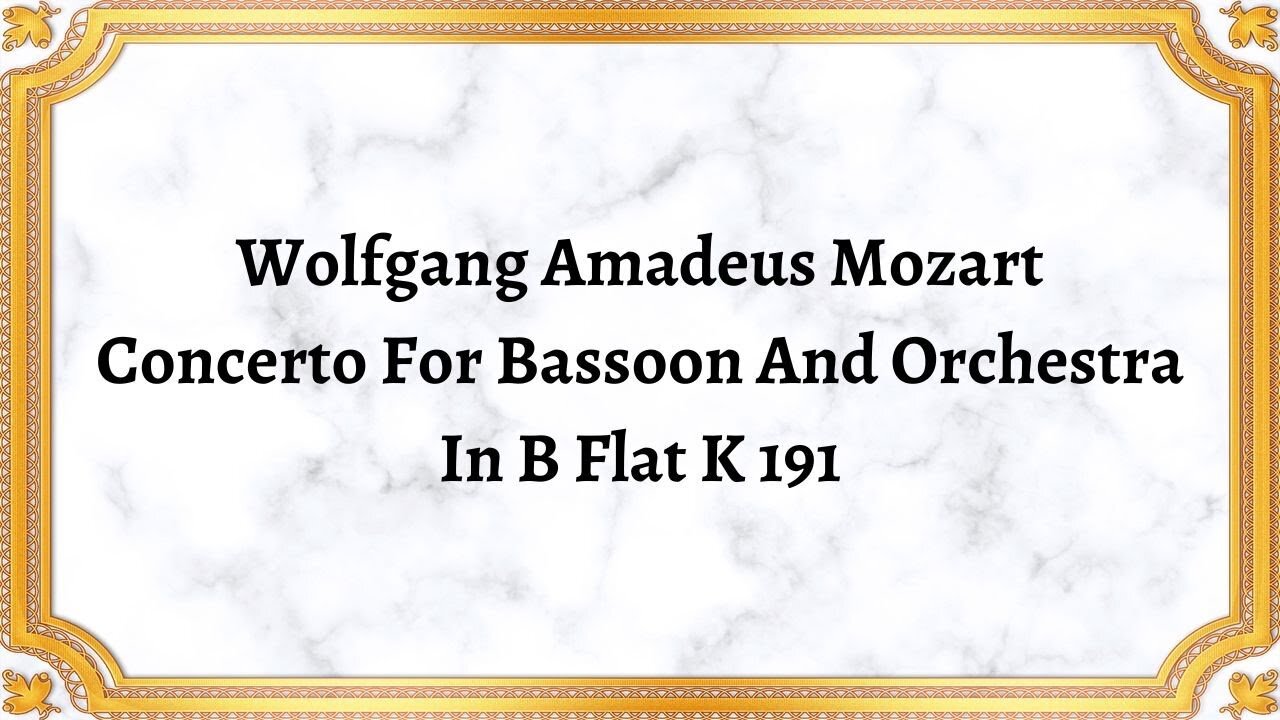Premium Only Content

Wolfgang Amadeus Mozart Concerto For Bassoon And Orchestra In B Flat K 191
Publication date 1954
ORCHESTRA OF THE VIENNA STATE OPERA
Conducted by ARTUR RODZINSKI
The Concerto for Bassoon and Orchestra in B flat major, K. 191, is a well-known work by the Austrian composer Wolfgang Amadeus Mozart. It was composed in 1774 when Mozart was just 18 years old, and it remains one of his most famous works for the bassoon.
This concerto is part of a larger group of works that Mozart composed for wind instruments, including other concertos for bassoon, clarinet, horn, and flute. The bassoon concerto is notable for its playful and virtuosic character, which showcases the bassoon's unique tone and agility.
The concerto consists of three movements. The first movement is marked Allegro, and it begins with an orchestral introduction that sets the stage for the solo bassoon's entrance. The soloist then takes over, presenting a lively and upbeat theme that is developed throughout the movement. The second movement, marked Andante ma Adagio, is more somber and introspective, featuring a lyrical melody that is passed between the soloist and the orchestra. The third and final movement, marked Rondo: Tempo di Menuetto, is a fast and playful finale that brings the concerto to a lively and exciting conclusion.
One of the unique features of this concerto is the way Mozart integrates the bassoon into the overall orchestral texture. Unlike some earlier works for the bassoon, where the instrument was often relegated to a more supportive role, Mozart gives the bassoon a prominent and virtuosic role throughout the concerto. This showcases the full range of the bassoon's capabilities, from its rich and sonorous low notes to its agile and virtuosic upper register.
Another noteworthy aspect of this concerto is its use of orchestration. Mozart was known for his skill in orchestration, and he makes full use of the orchestra's resources in this work. From the energetic string passages to the colorful wind and brass solos, the orchestra provides a rich and varied backdrop for the solo bassoon.
Overall, the Concerto for Bassoon and Orchestra in B flat major, K. 191, is a masterful work by Mozart that showcases the unique qualities of the bassoon while demonstrating the composer's skill in orchestration. Its playful and virtuosic character has made it a favorite among both performers and audiences, and it remains an important part of the bassoon repertoire to this day.
-
 24:35
24:35
Classical music_Music Inspiration
18 days agoMax Bruch Violin Concerto No. 1 in G minor, Op. 26
851 -
 46:34
46:34
Randi Hipper
1 hour agoWALL STREET'S CRYPTO BET REVEALED! HINT: IT'S NOT BITCOIN!
2.18K1 -
 LIVE
LIVE
The Mike Schwartz Show
1 hour agoTHE MIKE SCHWARTZ SHOW with DR. MICHAEL J SCHWARTZ 08-28-2025
4,172 watching -
 LIVE
LIVE
LFA TV
3 hours agoLFA TV ALL DAY STREAM - THURSDAY 8/28/25
4,867 watching -
 2:04:35
2:04:35
Game On!
20 hours ago $3.07 earnedCollege Football Is BACK! Week 1 Preview!
36.2K2 -
 4:00:18
4:00:18
The Bubba Army
1 day agoMinneapolis Shooter Story Unfolds! - Bubba the Love Sponge® Show | 8/28/25
74.5K9 -
 LIVE
LIVE
JuicyJohns
2 hours ago $0.26 earned🟢#1 REBIRTH PLAYER 10.2+ KD🟢
27 watching -
 LIVE
LIVE
GritsGG
2 hours agoWin Streaking! Most Wins 3485+ 🧠
95 watching -
 16:58
16:58
marcushouse
15 hours ago $4.39 earnedSpaceX Starship Flight 10: What Really Happened! 🚀
55.1K13 -
 3:47
3:47
Blackstone Griddles
15 hours agoCampground Meal Planning on the Blackstone Camping Griddle
31.5K2